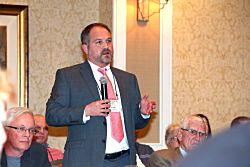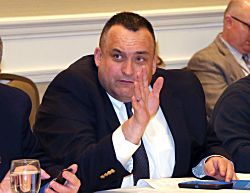New registration product demonstration highlights Sunday USTA Board committee meetings
February 28, 2016,by T.J. Burkett, Executive Editor, Hoof Beats Magazine
Columbus, OH — The demonstration of a new registration product through USTA Online Services highlighted committee meetings on Sunday (Feb. 28) at the USTA Board of Directors meeting at the Hilton-Easton.
Registration Committee
Registrar T.C. Lane presented his annual report. USTA membership dropped from 17,276 in 2014 to 16,856 in 2015. Foals registered dropped from 7,709 born in 2015 to 7,518 in 2015. Foal numbers were up year-over-year in Delaware, Indiana, Kentucky, Michigan and New Jersey. The top three states for mares bred last year were Ohio (2,478), Pennsylvania (1,950) and Indiana (1,816). The full report can be viewed here.

Registrar T.C. Lane gave a demonstration of the new online foal registration service that will soon be available to horse owners and breeders through USTA Online Services.
Lane also gave a demonstration of the new online foal registration service that will soon be available to horse owners and breeders through USTA Online Services. Lane said the product is currently in beta testing and is set for launch in mid-summer.
“It’s not really sexy, but I think it will really make your life easier,” Lane said.
Ellen Harvey, the USTA’s coordinator of Standardbred support operations as well as general manager of Harness Racing Communications, gave an update on the USTA’s aftercare efforts. She said that the Full Circle program has a current enrollment of 7,293, which is more than all other registries with Full Circle programs (Jockey Club, American Quarter Horse Association, Morgan and Saddlebred) combined.
Harvey added that 272 total horses have been converted to Pleasure Horse Registration, meaning the horse can no longer breed or race even if ownership of the horse changes. In 2015, 30 horses were helped by the USTA’s Save Our Standardbreds program, with $20,800 in USTA funds spent for their care.
Mark Wasserman, Dr. Todd Flower and Tara Long of Equi-Stem Biotechnologies gave a presentation about the advances their company has made in the storage and use of equine stem cells. The company and its processes was covered in the December 2015 Hoof Beats.
Driver/Trainer Committee
Director Mark Ford (District 8, New York) raised concerns about the onerous licensing and fingerprinting requirements for owners and horsemen who race in different jurisdictions. He said that although the National Racing Compact works to serve this need, it is not accepted in all harness racing jurisdictions.

USTA/Mark Hall photos
Director Mark Ford raised concerns about the onerous licensing and fingerprinting requirements for owners and horsemen who race in different jurisdictions.
“What can we do to make this process better or help you make this better,” Ford asked Ed Martin, president of the Association of Racing Commissioners International who was in attendance as a guest of the committee.
Martin replied that the ARCI is willing to sit down with USTA and the National Racing Compact to help develop a more inclusive nationwide licensing program. He said that the National Racing Compact is a separate organization from the ARCI, but the ARCI does set their policies.
USTA Regulatory Liaison Kent “Chip” Hastings updated the committee on the USTA Driving School. Hastings said that the school, soon to have its 18th iteration, will move from the Mark Ford Training Center in New York to the Delaware County Fairgrounds in Ohio on June 1-4.
Hastings also said that the USTA recently hosted its first-ever USTA Owners School in Delray Beach, Fla. He said that the USTA is finalizing a rebate program where new owners who attend a new owner event, buy a yearling at a participating sale, and register the transfer with the USTA could receive a rebate of $1,000 for purchases over $5,000, pending approval from consignors willing to give the rebates.
Mike McNeely of Van Gundy Insurance told the committee that enrollment is up slightly over last year and they have upped the weekly disability payment to $1,000 per week. More information can be found here.
Regulatory Committee
Hastings said that the USTA and Racing Officials Accreditation Program held a continuing education seminar at The Meadows last year. He said that there will be another one at The Meadows in November 2016.
The glaucine positives in the state of New York were briefly discussed. Committee chairman Joe Faraldo told the committee that to his knowledge, the New York Gaming Board is conducting an investigation into the positives before making an official announcement. He said that the names of the trainers charged were never released; when the Gaming Board contacted the trainers to tell them that an investigation was underway, word got out at racetracks and training centers.
Pari-Mutuel Committee
Director Chris Schick (District 3, California), who was honored by President Phil Langley for 20 years of service as a USTA director, gave an update on the USTA Strategic Wagering Program. He said that the program paid out $33,000 in missed guaranteed pools from the $75,000 budgeted.
Schick said that the program expanded into guaranteeing pools for pentafecta wagers. Pentafectas require winners to pick the top five finishers in order, and there can be multiple winnings tickets.
Schick said that the Strategic Wagering Committee worked with some tracks to conduct a test program to offer fewer exotic wagers in single races, such as dropping the superfecta pool and guaranteeing the trifecta pool.
“What we found out is that on that race, the guaranteed trifecta pool exceeded the pools for the trifecta and superfecta combined (on a similar past race).”
Director Brett Revington (District 6, Florida) asked if the USTA website could list upcoming carryovers at harness tracks. Schick said that the USTA does not have that information and must rely on the tracks to report carryovers, which are usually made into guaranteed-pool wagers and listed on handicapping.ustrotting.com.
Laura Horah of the Thoroughbred Racing Protective Bureau gave a presentation outlining their betting analysis platform and their investigations into inconsistent wagering patterns and payouts. She said the TRPB and USTA will meet in March to explore working together to set up a shared database of wagering data. The USTA would share charts with the TRPB, which would use its analysis software to look for betting anomalies that the USTA — along with state racing commissions — could then investigate.
Director Joe Pennacchio (District 6, Florida) urged the committee members that operate tracks to look at the timing of how purses and claim checks are paid out. He said that payouts can be wildly inconsistent and should be made more quickly to help horsemen and owners to be better able to manage their finances.
“Anybody who runs a business and has had to deal with cash flow knows that this is a one-time fix,” he said.
Lane told the committee that the USTA Executive Committee had decided on Saturday to continue to work with state regulators to explore the viability of timing races in 100ths of a second. A rule was passed and appeared in the USTA Rule Book as of Jan. 1, 2016, but the USTA board cannot enforce the rule pending changes in existing state regulations.
Fairs Committee (Saturday, Feb. 27)
Assistant Fair Liaison Jessica Schroeder reminded members of the Fairs Committee that the USTA is offering $10,000 to fairs in Matching Funds Grant money, along with $10,000 in promotional materials. Applications are due April 29. USTA Blue Ribbon Fair awards are chosen from MFG applicants.
Lane asked the committee for suggestions on how to improve USTA Online Entry. Then the members of the committee each shared updates on fair racing in their respective states.
Dr. John Mossbarger (District 1, Ohio) suggested that the USTA help Ohio fairs find entities that can coordinate pari-mutuel racing and photo finish at the fairs.
- Progress of social media marketing program discussed as USTA Board of Directors Meeting opens (Saturday, February 27, 2016)
The progress of the USTA-led social media marketing program was presented and debated vigorously during the opening day of the USTA Board of Directors Annual Meeting Saturday (Feb. 27) at the Hilton-Easton.
- General session kicks off USTA Board of Directors meeting on Sunday (Sunday, February 28, 2016)
The USTA donated $10,000 to the fight against decoupling in Florida and a challenge to the election of track directors in Ohio was defeated during the general session of the USTA Board of Directors Annual Meeting Sunday (Feb. 28) at the Hilton-Easton.
- USTA donates $10,000 to Florida decoupling effort (Sunday, February 28, 2016)
At Sunday’s (Feb. 28) Board of Directors Annual Meeting, USTA President Phil Langley presented a $10,000 check to Florida Standardbred Breeders and Owners Association President Joe Pennacchio to aid in the effort to oppose decoupling in Florida.
- Funding for social media approved as USTA Board Meeting concludes (Monday, February 29, 2016)
Funding for the social media, digital marketing initiative as well as monetary support for major-race television broadcasts were approved at the final general session of the USTA Board of Directors annual meeting Monday (Feb. 29).
